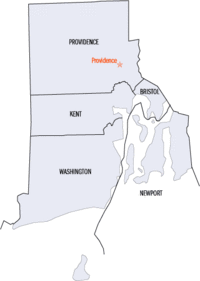Rhode Island statistical areas
The statistical areas of the United States of America comprise the metropolitan statistical areas (MSAs),[1] the micropolitan statistical areas (μSAs),[2] and the combined statistical areas (CSAs)[3] currently defined by the United States Office of Management and Budget (OMB).

Most recently on March 6, 2020, the Office of Management and Budget defined 1114 statistical areas for the United States,[4] including one combined statistical area and one metropolitan statistical area in the State of Rhode Island and Providence Plantations. Each of the five counties of Rhode Island are included in both these statistical areas. The table below shows the recent population of these statistical areas and their constituent counties.
Table
The table below describes the two United States statistical areas and five counties of the State of Rhode Island and Providence Plantations with the following information:[5]
- The combined statistical area (CSA) as designated by the OMB.[4]
- The CSA population according to 2019 US Census Bureau population estimates.[6]
- The core based statistical area (CBSA)[7] as designated by the OMB.[4]
- The CBSA population according to 2019 US Census Bureau population estimates [6]
- The county name
- The county population according to 2019 US Census Bureau population estimates [6]
- The Metropolitan Division name, if applicable[4]
- The Metropolitan Division population according to 2019 US Census Bureau population estimates [6]
See also
- State of Rhode Island and Providence Plantations
- Outline of Rhode Island
- Index of Rhode Island-related articles
- Book:Rhode Island
- Geography of Rhode Island
- Demographics of Rhode Island
- Rhode Island counties
- Rhode Island statistical areas
- Geography of Rhode Island
- Demographics of the United States
- United States Census Bureau
- United States Office of Management and Budget
- Statistical Area
- Primary Statistical Area
- List of the 725 PSAs
- Combined Statistical Area
- Core Based Statistical Area
- Metropolitan Statistical Area
- List of the 374 MSAs
- List of US MSAs by GDP
- Micropolitan Statistical Area
- List of the 581 μSAs
- Metropolitan Statistical Area
- Core Based Statistical Area
- Primary Statistical Area
- Statistical Area
References
- The United States Office of Management and Budget (OMB) defines a metropolitan statistical area (MSA) as a core based statistical area having at least one urbanized area of 50,000 or more population, plus adjacent territory that has a high degree of social and economic integration with the core as measured by commuting ties.
- The United States Office of Management and Budget (OMB) defines a micropolitan statistical area (μSA) as a core based statistical area having at least one urban cluster of at least 10,000 but less than 50,000 population, plus adjacent territory that has a high degree of social and economic integration with the core as measured by commuting ties.
- The United States Office of Management and Budget (OMB) defines a combined statistical area (CSA) as an aggregate of adjacent core based statistical areas that are linked by commuting ties.
- OMB BULLETIN NO. 20-01: Revised Delineations of Metropolitan Statistical Areas, Micropolitan Statistical Areas, and Combined Statistical Areas, and Guidance on Uses of the Delineations of These Areas Archived 2020-04-20 at the Wayback Machine. Office of Management and Budget. March 6, 2020.
- An out-of-state area and its population are displayed in green. An area that extends into more than one state is displayed in teal. A teal population number over a black population number show the total population versus the in-state population.
- "Annual Estimates of the Resident Population for Counties in the United States: April 1, 2010 to July 1, 2019". United States Census Bureau, Population Division. April 2020. Retrieved April 9, 2020.
- The United States Office of Management and Budget (OMB) defines a core based statistical area as one or more adjacent counties or county-equivalents having at least one urban cluster of at least 10,000 population, plus adjacent territory that has a high degree of social and economic integration with the core as measured by commuting ties. The core based statistical areas comprise the metropolitan statistical areas and the micropolitan statistical areas.
